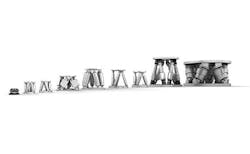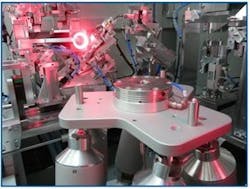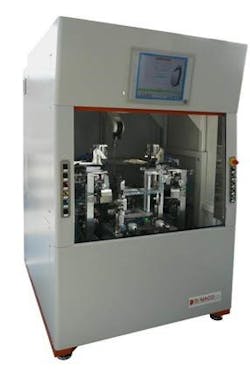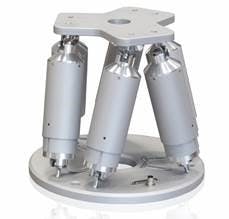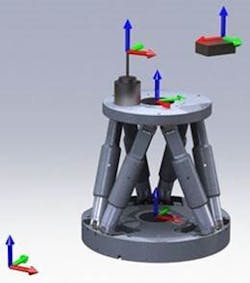Hexapod System Provides Flexibility for Automotive Manufacturing
The ever higher demand on the performance of headlights in automobiles drives automation and precision requirements of suppliers. A novel, compact dimensional measuring machine, designed by the DYMACO Group, now makes use of a 6-axis parallel-positioning and alignment system to provide more flexibility for in-line automated dimensional measuring of headlamps in the automotive industry.
Custom hexapod automates metrology processes in the DM401 DYMACO dimensional measuring machine
The DYMACO Group develops, designs, builds, and supports engineered-to-order automation systems, specializing in inspection and assembly equipment using intelligent motion control, vision, and robotics. The company has a rich history in the automotive lighting industry, having supplied automation systems and solutions for a number of automobile manufacturers.
The DYMACO DM401 Series inspection machine system uses specific measurement points for initial calibration based on computer aided design (CAD) data of the lamp. The lamp is picked from the production line and placed inside the inspection machine onto the hexapod 6-axis positioning system. The sample is adjusted quickly inside the machine to any defined position in 6D space with precision in the micron range. This is a fully automated metrology process.
DYMACO Dimensional Measuring Machine
The motion engine of the DM401 Series inspection machine is based on a customized H-820 Hexapod, engineered by Physik Instrumente (PI).
H-820 Hexapod Parallel Positioning System
Hexapods
Hexapods, also known as Stewart platforms or Gough/Stewart platforms, are 6-legged parallel-kinematic mechanism structures. In its most common form, a hexapod consists of two platforms, one fixed and the other movable, which are connected and supported by 6 actuator legs (struts) that expand and contract, acting in parallel between them. Coordinated motion of these struts enables the movable platform, and devices mounted to it, to move in any direction, operating with 6 degrees of freedom (DOF) relative to the other base platform. With 6 DOF the movable platform is capable of moving in the 3 linear directions – X, Y, Z (lateral, longitudinal, and vertical), and the 3 angular directions (pitch, roll, and yaw) singularly or in any combination. Because hexapods have all 6 DOF, they can perform manipulations that cannot be done with any other traditional motion system.
In a parallel-kinematic, multi-axis system, all actuators drive only one single platform, resulting in extremely low moving mass (inertia), high stiffness, and excellent dynamics and step/settle performance with high precision.
The latest versions of hexapods are capable of delivering unprecedented, ultra-precision resolution to as low as 0.03 microns (33 nm) of incremental motion, and some can provide velocity of several 10 mm/s, making them a preferred robotics system for industrial testing and positioning.
Hexapods’ high level of accuracy is a combination of extremely precise parts, precision assembly and testing, and sophisticated algorithms built into their high-speed controllers that take into account the exact tolerances of each strut and joint, and provide precise coordinates to each of the actuators.
Hexapods require the definition of a fixed pivot point as the center of rotation. Advanced hexapod designs make use of a virtual programmable pivot point for rotational alignment tasks, allowing motion around any point, not unlike the human hand.
The latest PC-based digital controllers, facilitated by open-interface architecture providing a variety of high-level commands, allow choosing any point in space as the pivot point for the rotation axes by software command. Target positions in 6-space are specified in Cartesian coordinates, and the controller transforms them into the required motion-vectors for the individual actuator drives. Any position and any orientation can be entered directly and the specified target will be reached by a smooth vector motion. The pivot point then remains fixed relative to the platform.
Hexapods, like this one from PI, allow the user to change the center of rotation and coordinate the system with a simple software command.
Flexibility for Automated Production Processes
Hexapods provide motion in XYZ and pitch, yaw, roll, and come in different configurations for applications including fiber optic alignment, motion simulation/cancellation, and image stabilization. Load capacities range from 4.4 lb. to several tons.
Recent hexapod designs provide extremely high stiffness and rigidity of their components and all moving parts, such as its bearings, joints, and drive screws. This results in high natural frequencies – 500 Hz at a 22 lb. load – which prevents bending in the struts or in the movable platform, making these hexapods capable of extreme accuracy and an ideal tool for precision machining, metrology, inspection, and testing applications.
Hexapods have a long history in automotive manufacturing. In fact, hexapods were first employed in industry in the late 1940s, operating within an automotive application. With the design developments that hexapod systems have recently experienced, automotive manufacturers requiring extreme high resolution and high accuracy can better capitalize on these advancements to reduce set-up and processing time, overall production cycle times, and ultimately reduced cost of operation.
